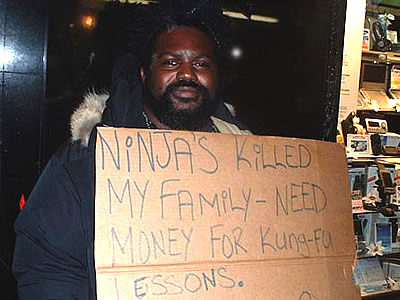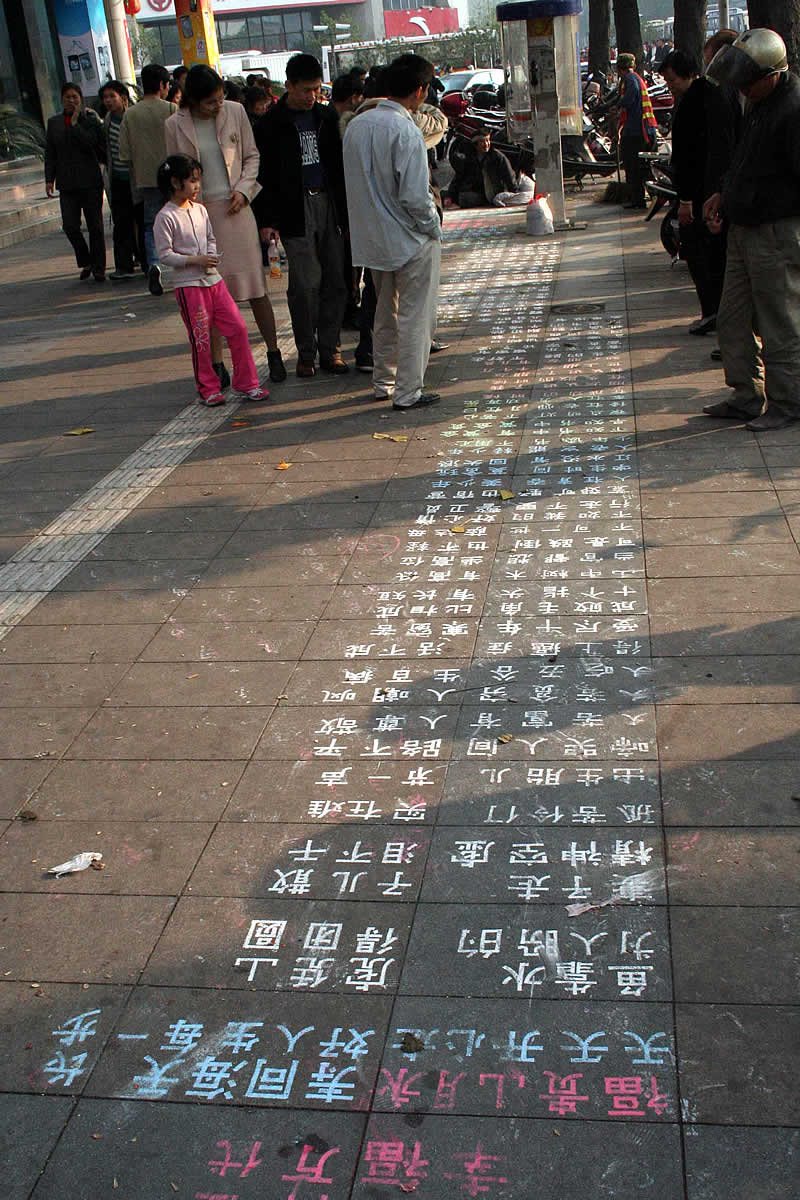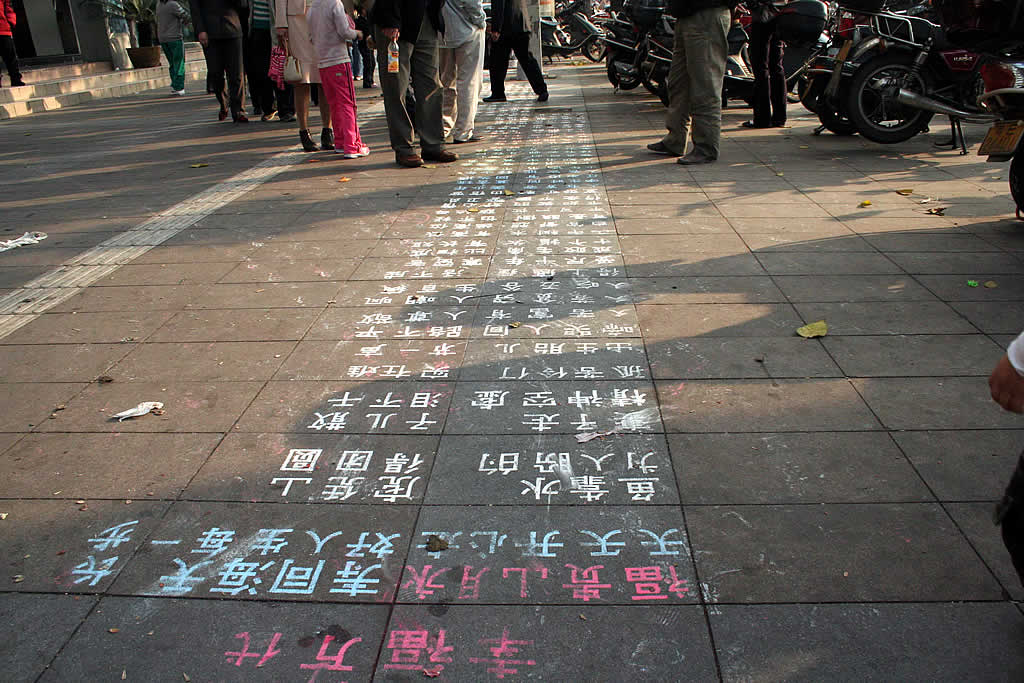Most of American beggars are White or Black, rarely Hispanics. The reason there aren’t any Hispanics is because the public has no sympathy for them. When most Americans see a brown-skin person, they automatically assume he is an illegal immigrant from Mexico (And if the brownie is at the airport, he is either a terrorist or food service worker). Most of Chinese beggars are from the poor villages, begging in the cities is they last resort for survival.
American beggars always ask for money but never willing to work for it, and eventually they will spend their money on booze or drugs (or upgrade to a larger shopping cart from Costco). Often, American beggars sound like telemarketers reading from a script. Hispanics do not beg; they would wait at labor market early in the morning for day-labor work. (I know this for fact, because I live in Arizona.) Aside from financial assistance, Chinese beggars would ask for fair treatment, fight for corruption, and etc (except “Whirled Peas”).
American beggars would automatically hold out cardboard signs with keywords like “hungry/work for food”, “veteran” and “God bless”. The “God bless” part has always annoyed me. If God was really looking out for you, then you would not be ending up on the streets, would you now? Perhaps the “God bless” is like the lucky-rabbit-foot, but I am doing pretty well before I saw your sign, therefore I will ignore it. Some beggars try to be funny with their signs like this guy:

Chinese beggars are very creative and sometimes impressive. Recently I have scored this photo set from Jon Rahoi, an American living in China.
Notice the poor fellow sitting under the payphone (top center). He has written down his hardship on the sidewalk in chalk. Every single character is written neatly as if it was printed. That takes some serious effort and dedication.


Jon writes: “The handwriting is what attracts people to read these long pleas for help. They can draw crowds. The beggars get a box of regular colored schoolchildren's chalk, and very firmly, very surely start writing. They don't waver or erase. They take their time, and it comes out looking like a font. Fascinating.
There are a lot of these people (impressive chalk writers) around, though they may have moved on now that New Year's is done. I'm here for 5 more days or so - I'll keep my eyes open for more, if you'd like.”
If I ever meet one of these Chalk-writing beggars in China, I would definitely hand over a
Related: Flickr - Beggars in China


i could be wrong, but just looking at the spacing and the "rhythm" of the words ... not only does it look like they're writing it neatly, it looks like they're doing it in verse, also ...
ReplyDeleteI've seen some of those beggars in China, but I think it's become cliche to beg that way.
ReplyDeleteThese schoolchildren would do the same thing, and the rich Chinese would yell at the kid and step all over the writing. I thought it was harsh, but then a Chinese friend told me 'it was poorly written and there are a lot of mistakes'.
Man, Chinese society sure is critical!
It is still impressive and interesting to see these beggars' dedication and effort.
ReplyDeleteMost American beggars I have encountered always ask "Man, can you spare some change" for food or bus fare.
One time I had a guy driving in a truck asking for gas money.
That is ridiculous.
I've also noticed an inflation in the amounts beggars ask for. When I was young, they'd ask for a quarter.
ReplyDeleteIn Australia, people come up to me asking for $2. $2! Man, that's pretty steep...
You could end up making a pretty decent living if you got 10 people to give you $2 in an hour.
Tian,
ReplyDeleteI'm sure you know that many, if not most, of the beggars in China's larger cities are professional panhandlers just like their American counterparts.
I won't argue that many beggars in China are doing so as a last effort of survival, but the largest majority of them seem to be organized with other beggars. The ones that tick me off the most though are the women who beg outside the bar streets late at night with half-clothed children in cold weather. The others are the bastards who bring children in from the countryside to beg or sell flowers to people on the street.
I used to give to beggars whenever I traveld to China as a tourist, but I learned quickly after I moved there. As a general rule of thumb, if I couldn't read the writing on the sidewalk, just follow the natives. If you see Chinese people giving money to a beggar, then there's usually a good reason for it.
Hi, Tian. Great story. Well, the real test awaits you in India (I only heard stories from friends being there).
ReplyDeleteI've got to say I'm torn on this one. I know almost all people in China are not well off at all and I feel I should give the beggars money. However, when I see beggars in some of the fast-developing cities in China where I know my suppliers are unable to find enough staff for their factories (not dodgey factories...good ones where they treat staff well) I feel pissed off. But then, I know plenty of people in those cities work for 3 Yuan/hr...betcha they make more begging. Maybe they are just smart.
ReplyDeleteAnother thing is that when I've been to the really poor places, there were fewer beggars. Everyone was just subsisting on what they could and upon seeing the little laowai, just wanted to talk to me, rather than ask for dosh.
Who knows what to do? Anyway, the characters in yr photos are truly very neat. I'm impressed.